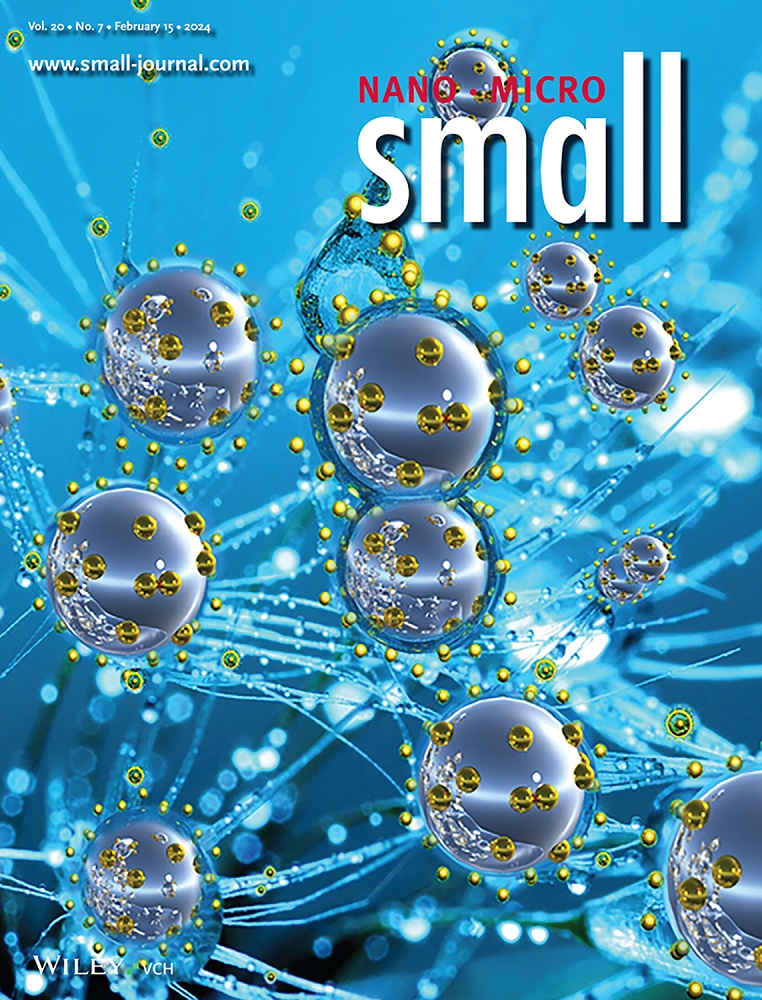用于生物成像应用的具有近红外 I 和 SWIR 双发射波段的 ZGSO:Cr3+,Ni2+ 持久性荧光粉
IF 13
2区 材料科学
Q1 CHEMISTRY, MULTIDISCIPLINARY
引用次数: 0
摘要
持久发光(PersL)被广泛应用于近红外(NIR-I,650-950 nm)成像,因为它们可以获得无背景图像。第二个短波-红外区域 SWIR-II(NIR-II,1000-1400 nm)的生物成像技术并不广泛,但由于其具有光子散射低、活体穿透深度增加和成像清晰度提高等优点,正在不断发展。本研究报告介绍了一种新材料 Zn1.33Ga1.33Ni0.005Cr0.005Sn0.33O3.995(ZGSO:Cr3+, Ni2+)的制备方法和完整光学特性,这种材料能同时发射深红/近红外-I 波段和西南红外(近红外-II 波段),显示了其在生物成像方面的潜力。ZGSO:Cr3+, Ni2+ 可通过不同的光源(如 X 射线、紫外线和可见光)激发,从而在双生物窗口(dual-BW)发出持续信号。通过在这种新合成的材料中整合从 Cr3+ 到 Ni2+ 的能量转移过程,试图探索共掺杂剂对信号强度和发射波长的影响。在初步的生物成像实验中,使用不同的方案测试了≈700 nm(近红外-I)和≈1300 nm(近红外-II)波长的 PersL,从而实现了具有良好空间分辨率和深度灵敏度的信号检测。双波长 PersL 成像策略扩展了高精度分析的工具箱,并首次实现了精确的高分辨率传感和追踪。本文章由计算机程序翻译,如有差异,请以英文原文为准。

ZGSO:Cr3+,Ni2+ Persistent Phosphors with Dual Emission in NIR-I and SWIR Ranges for Bio-Imaging Applications
Persistent luminescence (PersL) is widely used for near infrared (NIR-I, 650–950 nm) imaging as they allow getting images without background. Bio-imaging in the second shortwave-infrared region SWIR-II (NIR-II, 1000–1400 nm) is less widespread but is growing as it offers the advantages of low photon scattering, increased in vivo penetration depth, and improved imaging clarity. In this work, the preparation and the complete optical properties of a new material is reported, Zn1.33Ga1.33Ni0.005Cr0.005Sn0.33O3.995 (ZGSO:Cr3+, Ni2+) able of emitting in both deep-red/NIR-I and SWIR (NIR-II) and shows its potential in bioimaging. ZGSO:Cr3+, Ni2+ can be excited using different sources such as X-rays, UV, and visible light to emit persistent signals in dual biological windows (dual-BW). By integrating an energy transfer process from Cr3+ to Ni2+ within this newly synthesized material, the influence of co-dopants on signal intensity and emission wavelengths is sought to explore. PersL at ≈700 nm (NIR-I) and ≈1300 nm (NIR-II) have been tested in preliminary bioimaging experiments using different protocols, allowing signal detection with good spatial resolution and depth sensitivity. The dual-BW PersL imaging strategy expands the toolbox for highly accurate analysis and has, for the first time, allowed access to accurately high-resolution sensing, and tracing.
求助全文
通过发布文献求助,成功后即可免费获取论文全文。
去求助
来源期刊

Small
工程技术-材料科学:综合
CiteScore
17.70
自引率
3.80%
发文量
1830
审稿时长
2.1 months
期刊介绍:
Small serves as an exceptional platform for both experimental and theoretical studies in fundamental and applied interdisciplinary research at the nano- and microscale. The journal offers a compelling mix of peer-reviewed Research Articles, Reviews, Perspectives, and Comments.
With a remarkable 2022 Journal Impact Factor of 13.3 (Journal Citation Reports from Clarivate Analytics, 2023), Small remains among the top multidisciplinary journals, covering a wide range of topics at the interface of materials science, chemistry, physics, engineering, medicine, and biology.
Small's readership includes biochemists, biologists, biomedical scientists, chemists, engineers, information technologists, materials scientists, physicists, and theoreticians alike.
 求助内容:
求助内容: 应助结果提醒方式:
应助结果提醒方式:


